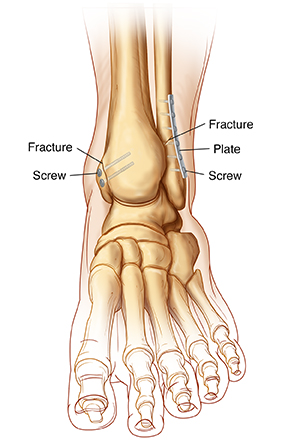Understanding Tibia/Fibula Fracture Open Reduction and Internal Fixation (ORIF)
Open reduction and internal fixation (ORIF) is a type of treatment to fix a broken bone. It puts the pieces of a broken bone back together so they can heal. Open reduction means the bones are put back in place during a surgery through an open cut (incision). Internal fixation means that special hardware is used to hold the bone pieces together. This helps the bone heal correctly. The procedure is done by an orthopedic surgeon. This is a doctor with special training in treating bone, joint, and muscle problems.
How does a tibia/fibula fracture happen?
The tibia and fibula are the 2 bones of your lower leg. The tibia is your shinbone. It’s the larger bone. The fibula is the smaller bone that sits next to the tibia. The top of the tibia forms part of the knee joint. The bottom of both the tibia and the fibula forms the upper part of the ankle joint.
An injury may break (fracture) your tibia, your fibula, or both into 2 or more pieces. This might happen near your knee, in the middle of your shin, or near your ankle. A fracture near your ankle may be called a broken ankle. You may have a fracture in 1 or both bones. A bone may break but the pieces are still lined up correctly. Or the pieces may not line up correctly. This is called a displaced fracture.
A broken tibia or fibula can happen from a car or bicycle accident, contact sports, a fall, or activities with movements that you do over and over again. Older adults with low bone density (osteoporosis) are more at risk for breaks in these bones.
Why is ORIF done?
During an open reduction, the bone pieces are put back in their proper alignment. The bones are then connected back in place with hardware. This is called internal fixation. The hardware may include screws, plates, rods, wires, or nails. This helps the bone heal correctly.
Most people don't need ORIF for tibia/fibula fractures. They may have bones put back in place without surgery. They may have pain medicine, a cast, splint, or a special brace, and physical therapy. You are likely to need ORIF if:
-
You have a displaced fracture.
-
Part of your tibia or fibula broke through the skin.
-
Your tibia or fibula broke into several pieces.
-
Your fracture involves your knee or ankle joint.
-
You had other treatment, but your fracture did not heal well.
How is a tibia/fibula fracture ORIF done?
The surgery is done by an orthopedic surgeon. The surgeon will make a cut (incision) through the skin and muscle of your leg. They will put the pieces of your tibia or fibula, or both, back into place (reduction). The pieces of the broken bones will be secured to each other (fixation). Your healthcare provider may use screws, metal plates, wires, or pins. For a fracture in the middle of the tibia, a special metal nail may be put through the middle of the bone.

What are the risks of tibia/fibula fracture ORIF?
All surgery has risks. The risks of tibia/fibula fracture ORIF include:
-
Infection
-
Bleeding
-
Nerve damage
-
Bone healing out of alignment
-
Blood clots
-
Fat embolism
-
Broken screws or plates
-
Loss of movement
-
Damage to the bones from the hardware
-
Skin irritation from the hardware
-
Misaligned bones
-
Problems from anesthesia
-
Need for additional surgery
Your risks vary based on your age and general health. For example, if you are a smoker or if you have low bone density, you may have a higher risk for certain problems. People with diabetes may also have a higher risk for problems. Talk with your surgeon about which risks apply most to you.